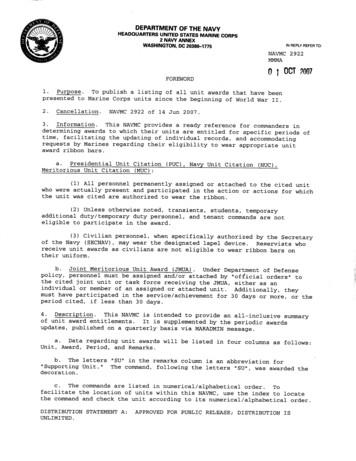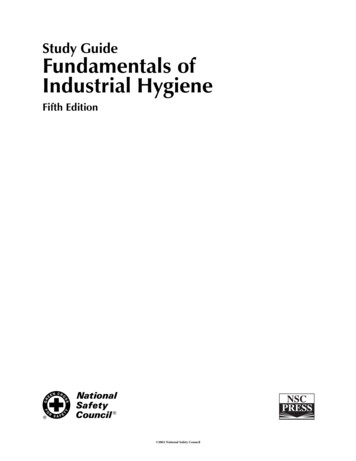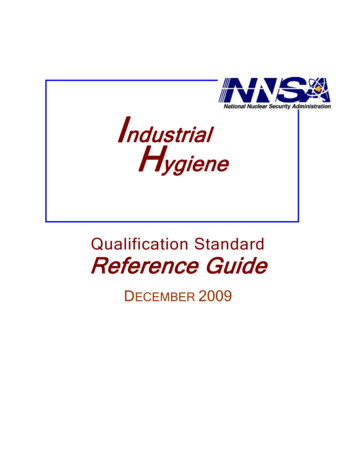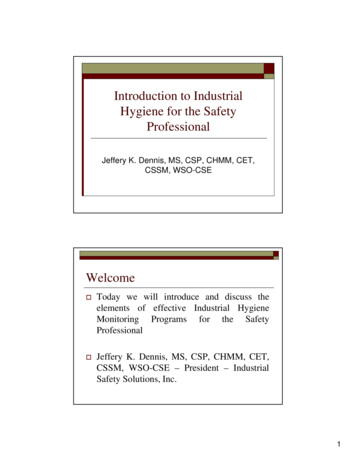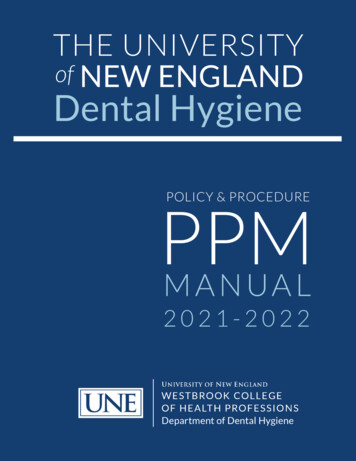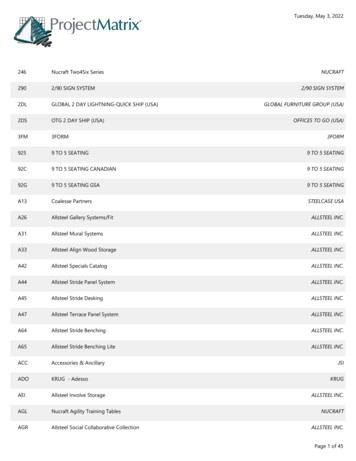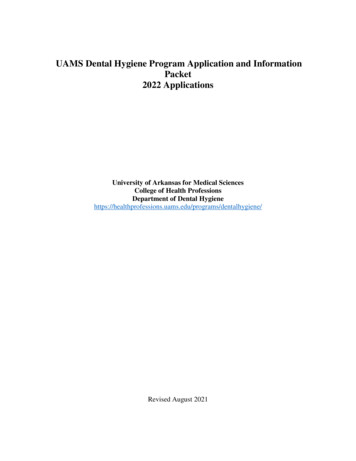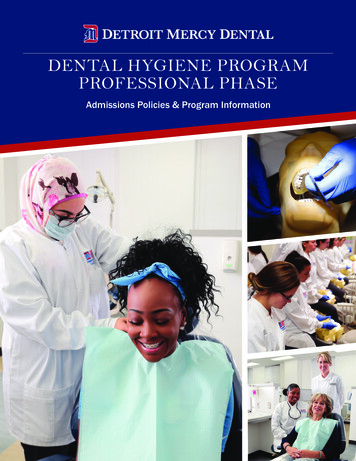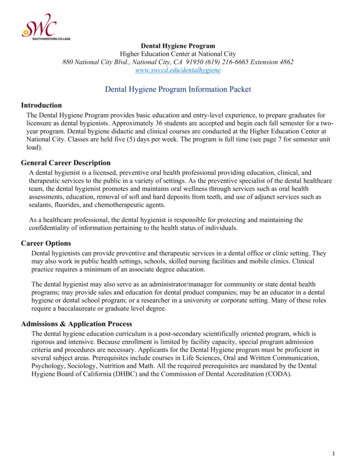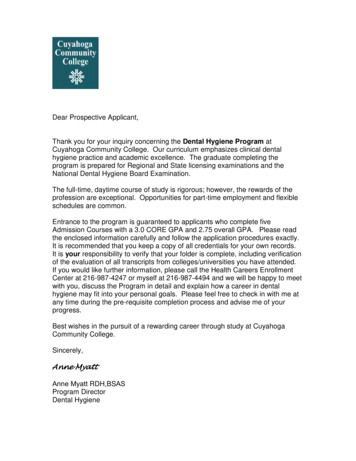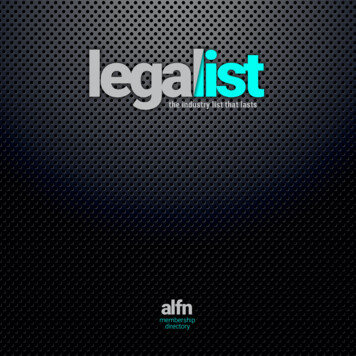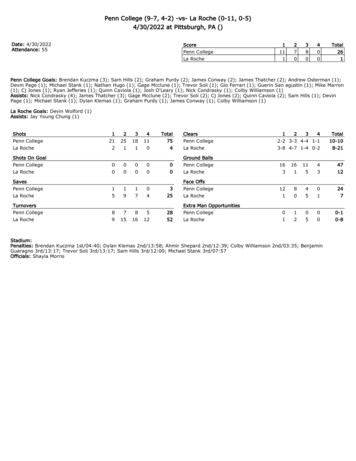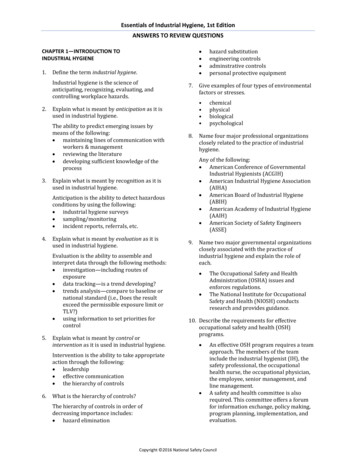
Transcription
Essentials of Industrial Hygiene, 1st EditionANSWERS TO REVIEW QUESTIONSCHAPTER 1—INTRODUCTION TOINDUSTRIAL HYGIENE 1.Define the term industrial hygiene.2.Explain what is meant by anticipation as it isused in industrial hygiene.3.4.5.6.Industrial hygiene is the science ofanticipating, recognizing, evaluating, andcontrolling workplace hazards.The ability to predict emerging issues bymeans of the following: maintaining lines of communication withworkers & management reviewing the literature developing sufficient knowledge of theprocess7.Give examples of four types of environmentalfactors or stresses.8.Name four major professional organizationsclosely related to the practice of industrialhygiene.Explain what is meant by recognition as it isused in industrial hygiene.Anticipation is the ability to detect hazardousconditions by using the following: industrial hygiene surveys sampling/monitoring incident reports, referrals, etc.Explain what is meant by evaluation as it isused in industrial hygiene.Evaluation is the ability to assemble andinterpret data through the following methods: investigation—including routes ofexposure data tracking—is a trend developing? trends analysis—compare to baseline ornational standard (i.e., Does the resultexceed the permissible exposure limit orTLV?) using information to set priorities forcontrolExplain what is meant by control orintervention as it is used in industrial hygiene.Intervention is the ability to take appropriateaction through the following: leadership effective communication the hierarchy of controlsWhat is the hierarchy of controls?The hierarchy of controls in order ofdecreasing importance includes: hazard eliminationhazard substitutionengineering controlsadminstrative controlspersonal protective equipment9. chemicalphysicalbiologicalpsychologicalAny of the following: American Conference of GovernmentalIndustrial Hygienists (ACGIH) American Industrial Hygiene Association(AIHA) American Board of Industrial Hygiene(ABIH) American Academy of Industrial Hygiene(AAIH) American Society of Safety Engineers(ASSE)Name two major governmental organizationsclosely associated with the practice ofindustrial hygiene and explain the role ofeach. The Occupational Safety and HealthAdministration (OSHA) issues andenforces regulations.The National Institute for OccupationalSafety and Health (NIOSH) conductsresearch and provides guidance.10. Describe the requirements for effectiveoccupational safety and health (OSH)programs. An effective OSH program requires a teamapproach. The members of the teaminclude the industrial hygienist (IH), thesafety professional, the occupationalhealth nurse, the occupational physician,the employee, senior management, andline management.A safety and health committee is alsorequired. This committee offers a forumfor information exchange, policy making,program planning, implementation, andevaluation.Copyright 2016 National Safety Council
Essentials of Industrial Hygiene, 1st EditionANSWERS TO REVIEW QUESTIONS11. Describe the role of the industrial hygienist onthe OSH team.The role of the industrial hygienist on the OSHteam is to: protect the health of workers maintain an objective view counsel employees respect confidences advise honestly and report accurately be responsible to employer/client7.CHAPTER 2—THE OCCUPATIONAL SAFETY ANDHEALTH ACT AND INDUSTRIAL HYGIENE1.2.3.4.5.6.What does the Fourth Amendment protect?Does this same right apply to organizationsand businesses?The Fourth Amendment protects citizensfrom unreasonable search and seizure. Thegovernment may not conduct any searcheswithout a warrant, and such warrants must beissued by a judge and be based on probablecause. These rights extend to organizationsand businesses.If a neighborhood group sues a company forallowing lead paint chips to blow off itsproperty and into the neighborhood, whatconstitutional amendment allows thecompany to have a jury in the civil suit?The Seventh Amendment guarantees a jurytrial for civil cases in federal courts.Under what branch of the U.S. governmentdoes the Department of Labor fall?ExecutiveAt what phase of the preparation of aproposed bill is an industrial hygienist likelyto be called to testify before Congress?An industrial hygienist would likely be calledto testify when the bill is being reviewed bycommittees or subcommittees.What is the Federal Register?It is where new laws and regulations areannounced and eventually published.What type of information is typically reviewedin appeals courts?The information about how the case was triedis reviewed to determine whether there wereany errors that may have affected theoutcome adversely.What is the role of federal agencies andcommissions? What are two agencies whoseresponsibilities involve industrial hygiene?These agencies and commissions are createdin various capacities to develop laws orregulate various activities. The following areagencies with industrial hygieneresponsibilities: Federal Communications Commission Nuclear Regulatory Commission Environmental Protection Agency Mine Safety and Health Administration8.When was OSHA created?9.To whom or what did the fellow servant ruleapply, and how was it used?1970The fellow servant rule applied to workplacesand stated that employers were not liable forworkplace injuries that resulted from thenegligence of other employees. Manyemployers used this clause to relievethemselves from injuries to their employees.10. Name two instances where OSHA regulationsdo not apply.OSHA regulations do not apply to soleproprietors where the owner is the onlyworker, and they do not apply to farms withfewer than 10 workers or family members.11. What is the General Duty Clause?Section 5(a)(1) of the OSH Act, which statesthat each employer shall “furnish to each ofhis employees employment and a place ofemployment which are free from recognizedhazards that are likely to cause death orserious physical harm to his employees.”12. What is NIOSH’s role?NIOSH is responsible for setting nationalstrategic goals for workplace health andsafety. They are charged with conducting afocused program of research to reduceinjuries and illnesses among workers in highpriority areas and high-risk sectors. NIOSH isalso responsible for implementing andmaintaining a system of surveillance for majorworkplace illnesses, injuries, exposures, andhealth and safety hazards.Copyright 2016 National Safety Council
Essentials of Industrial Hygiene, 1st EditionANSWERS TO REVIEW QUESTIONS13. Explain the difference between a performancestandard and a specification Standard.Specification Standards are clear rules thatsay exactly what engineering or designcriteria must be met to protect workers froma particular hazard. Performance standards,on the other hand, only state the levels of thetoxic chemical in the air that are acceptable.3.4.14. Explain the difference between a horizontalstandard and a vertical standard?Vertical standards are rules that typicallyapply to only one industry where a particularhazard exists. Horizontal standards are rulesthat can apply to nearly any workplace orindustry across the board.15. Explain the difference between an OSHAspecial emphasis program and a regionalemphasis program.The special emphasis program is morenational in nature and could apply anywhere.The regional emphasis program focuses ondifferent parts of the country or works inrelation to the types of jobs or industries thatexist there.5.2.Answers may vary.Why are established procedures necessary,and how do they relate to worker safety?Procedures provide explicit instructions forhow to perform a task or operate equipment.Sometimes they provide important safetyinformation regarding how to do the jobwithout being injured.How does quality assurance apply to safety?Quality assurance provides a means to ensurethat jobs and workplaces are as safe aspossible in accordance with programs andprocedures. Quality assurance represents anorganizational way to ensure that work isbeing done correctly and safely.6.How does a program review differ from anaudit?What is a “culture of safety,” and how is itcreated and developed within anorganization?7.What are three of the basic businessprinciples associated with TQM methods?Why is the management of industrial hygieneand safety a good business practice evenwhen there are no regulations covering acertain area or work hazard?8.CHAPTER 3—MANAGEMENT SYSTEMS1.Create a short policy describing a beautysalon’s safe operations and commitment tosafety.A culture of safety involves setting the valuesand attitudes regarding safety issues to beshared by all work groups and individualswithin the organization. Safety culture meansencouraging workers to report unsafe orpotentially illegal conditions, accidents,injuries, illnesses, and near misses, withoutreprimand.There is an ethical element that requiresemployers to provide a safe and healthfulworkplace. Plus, the efficient and productiveoperation of the organization is closely linkedto the level of safety in the organization.9.Audits are typically conducted as a snapshotto evaluate a specific aspect of a program overa specific timeframe. Program reviews tend tobe comprehensive analyses of the regulationsand written documents within theorganization.TQM is geared toward customer satisfaction,requires employee involvement, relies oneffective communications, is focused onprocesses and efficiency, and all the variousbusiness parts are fully integrated. Qualitycontrol is an integral part of the businessprocess, and it uses strategic long-termplanning for setting and achieving goals, and itis continually trying to improve.What are the four parts of the Deming wheelused to describe the TQM process?Plan, Do, Study, ActWhat type of safety management system isdesigned around the collection and statisticalanalysis of data?Six sigmaCopyright 2016 National Safety Council
Essentials of Industrial Hygiene, 1st EditionANSWERS TO REVIEW QUESTIONS10. What does the International StandardsOrganization (ISO) do?The ISO is a nonprofit network ofinternational standards-development bodiesthat create consensus standards on all aspectsof technology and manufacturing. There areseveral ISO standards related to businessoperations, quality assurance, theenvironment, and safety.11. What is the highest level a company can attainin OSHA’s Voluntary Protection Programssequence, and what does a company need todo to be accepted into the program?The Star Program is the highest level, which isfor exemplary worksites with comprehensiveand successful safety and health managementsystems.4.neuronal markers of toxicity like gait andbehavior changes; teratogenicityList and describe Hill's criteria of causation. 12. What is the most important step whenselecting an alternative, safer process orchemical? Why?All of the steps in the alternative chemicalprocess are important, however, a key featureof the system is tied to the concept ofcontinuous improvement. Therefore, the laststep of continually reviewing changes andconditions, and making improvements isprobably the most important step in theprocess. CHAPTER 4—BASIC CONCEPTS IN INDUSTRIALTOXICOLOGY1.What is the difference between mechanism ofaction and mode of action? 2.What are biomarkers, and why are theyimportant? 3.What are some examples of biomarkers?Mechanism of action is a detailed descriptionof the events that cause an effect. Mode ofaction describes only the key events of themechanism of action.Biomarkers are measurable signs of toxiceffects of chemicals. They allow for observingand measuring the progress of toxic effects tochemicals.Clinical measures like body weight, urinalysismeasurements, and hematological markers;pathological measurements like changes ingross physiology or histopathology changes;First Criterion: Strength. Strength of theeffect describes the strength ormagnitude of the relationship betweenevents. A strong association between theexposure and the specific effect means itis more likely that the exposure is causalto the effect. In toxicology, this would beseen as a high incidence of effect at agiven dose or the appearance of severeeffects as opposed to mild effects.Second Criterion: Consistency. Differentstudies with potentially differentpopulations seeing a correlation betweena specific exposure and a specific effectgreatly increase the chances of a causalrelationship between the exposure andthe effect. This is also true for laboratoryand epidemiological data. This criterionalso incorporates information consistencyin the range of biological responseswithin a study. For example, in atoxicology study where an increase inblood markers of liver damage wasobserved, did the histopathology observeany evidence of damage?Third Criterion: Specificity. The thirdcriteria of consideration are specificity. Ifa rare disease or effect is associated witha group of people who all had a specificexposure and the incidence of the effect inthe population is not otherwiseexplainable, the specificity of theassociation between the exposure and theeffect greatly strengthens the case forcausality of the exposure.Fourth Criterion: Temporality of Events. Afourth criterion of interest is thetemporality of the events. Fordetermining that an exposure causes aneffect and perturbs a particularmechanism of action, the exposure mustoccur before the effect occurs.Fifth Criterion: Coherence andPlausibility. The fifth criterion to examineis the coherence and plausibility of therelationship between the exposure andthe potential effect. Does the laboratorybiological evidence for an exposure to achemical show that a chemical is usuallynot absorbed into the body at all? Then itis not plausible that a systemic effect islikely for that chemical. The question forCopyright 2016 National Safety Council
Essentials of Industrial Hygiene, 1st EditionANSWERS TO REVIEW QUESTIONS this criterion is, “Is the effect reasonablegiven all the other known data on thischemical?”Sixth Criterion: Dose-ResponseRelationship. It is important to establish adose-response relationship between theexposure and the effect. Exposure to alarge amount of the agent of interestshould cause a greater response thanexposure to a lesser amount. If the agentof interest accumulates in the body, thenchronic exposure should cause anincrease in effect. In addition, the dose forearly (less severe) key events should belower than the later (more severe) effects.5.What is ADME?6.What is the blood-gas partition coefficient?7.What is biotransformation?8.Define Vmax and Km. If a chemical has a Vmax of150 mg/min and a Km of 3 mg/L, what is thatchemical's intrinsic clearance rate?Absorption, distribution, metabolism,eliminationThe constant that describes the ratio of a gasin the alveolar air compared with the blood.It is the transformation of a chemical to adifferent metabolite by metabolism.Vmax is the measure of how fast an enzyme canclear a chemical. Km is the affinity of anenzyme for a chemical.Clearance 9.150 mg/min 503 mg/LWhat is the half-life of a chemical that has avolume of distribution of 2 L and that can becleared from 1,500 mL of blood per hour?Kel Vd / Cl 2 L / (1.5 L/hour) 1.33 hour-1T1/2 0.693 / Kel 0.693 / 1.33 hour-1 0.52 hours 31 minutes10. What is the difference between an acute andchronic exposure, and which is moredangerous?Acute exposure is a short-term exposure;chronic exposure is a long-term or repeatedexposure. Which is more dangerous dependson the dose and the chemical. An acuteexposure to a low dose may be safe when achronic exposure may be dangerous.CHAPTER 5—OCCUPATIONAL EXPOSURELIMITS AND ASSESSMENT OF WORKPLACECHEMICAL RISKS1.What are the components of the riskassessment and risk management frameworkof NAS?Problem formulation, risk assessment, riskmanagement, and risk communication.2.What is the general purpose of an OEL?3.The risk assessment phase includes severaldistinct activities pertinent to thedevelopment and application of the OEL. Whatdo they include?4.5.The OEL is intended to provide a quantitativeestimate of the maximum air concentrationthat is believed to be safe for an occupationalpopulation that may be exposed daily for aworking lifetime.Hazard characterization, dose-responseassessment, exposure assessment, and riskcharacterizationIn addition to its actual value, what are theother elements of an OEL?Concentration units presented, the timeweighted averaging recommended, and theprovision of additional notations for hazardsnot addressed quantitatively in the OEL.Identify and describe the three types of OELs. The full-shift TWA is usually presented asan 8-hour or 10-hour time-weightedaverage limit.STEL is also a time-weighted averageexposure limit, but the averaging time isshort.Ceiling limit is a maximum exposureconcentration that should not beexceeded at any time during the workday.Copyright 2016 National Safety Council
Essentials of Industrial Hygiene, 1st EditionANSWERS TO REVIEW QUESTIONS6.Identify the key steps to OEL derivation. 7.Identify and describe the basis of each of thesix common uncertainty factors. 8.9.Define the scenario and develop theproblem formulation.Gather and summarize the scientific data.Select a point of departure if necessary;perform extrapolations to increase therelevance of the point of departure.Adjust for route of exposure and exposureduration/patterns.Perform animal-to-human extrapolationsand human variability extrapolations.Apply any additionally requireduncertainty factors.Submit value for external review.Animal to Human. Adjusts for differencesin sensitivity between animals and theaverage human, when the POD is basedon animal studiesAverage Human to Sensitive Human.Adjusts the POD for the differencebetween the average human and the mostsensitive applicable workersubpopulationLOAEL to NOAEL. Adjusts for uncertaintyin the value of the POD as an estimate ofthe threshold for the onset of effects, ifbased on a LOAEL rather than a NOAELShort-term to Long-term Exposure.Adjusts for the possibility of identifying alower POD for chronic toxicity whenextrapolating from a study of shorterdurationDatabase Insufficiency. Adjusts for thepossibility of identifying a lower POD (ormore sensitive effect) if additional studieswere availableModifying Factor. Adjusts for additionalconsiderations, including difference inexposure routes or other toxicokineticconsiderationsHow does the industrial hygienist calculatethe HQ?HQ Exposure / OELTrue or False: The HQ concept is the mostcommon risk characterization methodemployed in occupational risk assessments.True10. What concept can be used to provide aquantitative exposure benchmark when anOEL is not available?The Hierarchy of OELsCHAPTER 6—GASES AND VAPORS1.If acetone has an SG of 0.79, how many mL arein 2.0 g of acetone?2.What is the term for the temperature at whicha fire can be maintained?3.a.2.53 (mL)Fire pointFill in the blanks in the table below for ppm tomg/m3 conversions (assume NTP):Chemicala. methanolb. naphthalenec. phenold. ppm1,0001.91014.7mg/m31,30910.038100What is the name of the direct-reading meterthat uses an ultraviolet lamp to ionize organiccompounds to detect and quantify them?b.Photoionization detectorc.4.0 L per minIf you sampled for 4 hours and obtained asample volume of 960 L, what was the flowrate?A tank car with a tight-fitting lid is reported tocontain pure acrylonitrile monomer. You havebeen asked to verify the tank car’s contents.Estimate the concentration of ethyl alcohol inppm in the air space above the liquid.Acrylonitrile monomer has a vapor pressureof 83 mmHg.ppm Pv/Patm 106 83/760 106 109,210 ppmAccording to a NIOSH analytical method, theminimum level of detection (LOD) for achemical is 50 µg, the recommended exposurelimit for this chemical is 1.0 mg/m3, and thefraction is set at 0.1. How many liters of airmust be collected to obtain the minimumsample volume?d.500 (L)Copyright 2016 National Safety Council
Essentials of Industrial Hygiene, 1st EditionANSWERS TO REVIEW QUESTIONS8.9.What are five useful features of direct-readingindustrial hygiene air monitoringinstruments?Any of the following: Real-time information Lightweight, portable Rugged Simple to operate Quickly indicate presence of potentiallydangerous levels of gases and vapors Complex system that can differentiate andquantify numerous unknown chemicals inthe air at the same time Look at short exposures, ceiling limits,short-term exposure limits, workpractices, motivational tools to detectleaks in systems and ventilation allowingfor timely repairsWhat is the principle of operation ofelectrochemical sensing portableinstruments?Chemical oxidation of the test gas10. What is the principle of operation of a flameionization detector?14. What is the main purpose of collecting a grabsample when analyzing air contaminants?a. Collect a relatively instantaneous sampleto be compared with (ceiling limits)15. What is the main advantage of passivedosimeters?b. They are lightweight and don’t interferewith the workers during their activities.16. Which of the following is NOT a principle ofoperating a direct-reading instrument?Temperature, humidity, particulates, otheraerosols, oxygen concentration, pressure12. What type of direct-reading instrument wouldlikely be used to monitor for carbon monoxideor oxygen?Electrochemical13. If you have a 1-L balloon of nitrogen gas at aninitial pressure of 760 mmHg and you takethat balloon to the top of a mountain wherethe pressure is only 610 mmHg, what is thenew volume of nitrogen in the balloon?Gravimetricc.Diffusion17. What is the basic principle of operating apassive air-sampling device?CHAPTER 7—AEROSOLS1.Creates organic ions by passing a hydrogengas through a flame and then measures theconductivity change in the flame as aconcentration of the gas11. What environmental conditions can affect theaccuracy and usefulness of direct-readinginstruments?b.2.In what ways are mists different from fogs?Fogs tend to be smaller than mists (1 µm to 10µm, rather than 10 µm to 100 µm in the caseof mists). Mists tend to be created by physicalprocesses such as splashing, agitating,electroplating, bubbling, painting, and otherspraying applications. Because the chemicalcomposition of a mist doesn’t change fromthat of its parent solution, the mist retains thehazardous properties of its parent solution.Because fogs are smaller than mists, they tendto remain in the air longer than mists and canalso penetrate more deeply into the lungs.Why is aerosol size important whendetermining where aerosols will interact inthe lungs?Larger particles tend to be trapped in theupper parts of the respiratory tract such asthe nose and throat. Smaller particles canmake it all the way down into the alveoliwithout colliding with the trachea orbronchioles.1.25 LCopyright 2016 National Safety Council
Essentials of Industrial Hygiene, 1st EditionANSWERS TO REVIEW QUESTIONS3.In the field, you set the air-sampling pump’sflow rate to 1.7 L/min using a precisionrotameter and sample the air for 350 min. Younote and record the field temperature as 80oF(26.6oC) and the barometric pressure as 650mmHg. Calculate the corrected volume of airin liters for normal temperature and pressure(25oC and 760 mmHg). Show all work.Qactual Qcal (Tactual [ K])/(Tcal [ K]) (Pcal[mmHg])/PactualQactual 2.0 L/min (298 [ K])/(299.6 [ K]) (650 [mmHg])/(760 [mmHg])Qactual 1.7 L/minR Q/T1.7 L/min Q/350 minQ 595 LCHAPTER 10—DERMAL HAZARDS1.2.3.4.Why is the study of dermal exposure tohazardous agents important today?There are approximately 13 million workersin the United States with the potential for skinexposure to hazardous chemicals. Workplaceskin diseases account for 15–20% of allreported occupational diseases. The economicburden in total annual costs associated withoccupational skin disease is estimated atseveral billion dollars.Why have dermal routes of occupationalexposure become more prevalent in the pastseveral years?Partly because they have been identified assignificant routes and partly because lessvolatile chemicals are replacing those thatevaporate easilyHow many square centimeters of skin doaverage hands and forearms have in total?2,030 cm2What are three of the primary functions of theskin?Any of the following: Provide a barrier to the environment Protect muscles and tissues Keep harmful materials out Let necessary materials in Temperature control Neurosensory reception5.6.7.8.9.What are the three main means of permeationof agents through the skin?Travel on the intracellular lipid pathway,transcellular permeation, and throughappendages in the skinList at least three skin factors that mayincrease chemical absorption and permeationthrough the skin.Any of the following: Younger skin Wet skin Broken skin Anatomical location Skin thickness Individual difference Metabolic ratesWhat are three exposure factors that mayincrease chemical absorption and permeationthrough the skin?Any of the following: Chemical type Chemical concentration Duration of exposure Surface area exposed Ambient temperatures Use of protective clothingWhat are three chemical factors that mayincrease chemical absorption and permeationthrough the skin?Any of the following: Chemical volatility and vapor pressure Molecular weight Hydrophilic or lipophilic properties Specific chemical structureWhat are the two primary differencesbetween irritant contact dermatitis andallergic contact dermatitis?Allergic contact dermatitis is an inflammationof the skin caused by an immunologic reactiontriggered by dermal contact with a skinallergen. Allergic contact dermatitis reactionsare not confined to the area of exposure.10. The best ways to minimize or controlexposures through the dermal route arethrough (1) , (2) , and(3) .elimination, substitution, process changesCopyright 2016 National Safety Council
Essentials of Industrial Hygiene, 1st EditionANSWERS TO REVIEW QUESTIONS11. Splash guards, lids, and glove boxes areexamples of controls for dermalexposures.7.12. Why does chemical PPE need to be changedperiodically?8.engineeringBecause the equipment can become saturatedwith the chemical or physically degraded13. What are some of the drawbacks of using PPEas a worker protection strategy?PPE is thin and a last line of defense to protectthe worker. It has limited durations of use.Workers need to be trained on its proper use,maintenance, and limitations. It can be moreexpensive to implement than other controls.CHAPTER 11—NOISE1.2.Find the wavelength in meters of a puresound at the following frequencies:a.b.c.λ 0.172 mλ 0.404 mλ 0.013 mHow loud in decibels is an audio system witha sound power rating of 280 W per channel?Lw 144 dB3.How loud in dB is a drill press with a soundpower rating of 0.003 W?4.What is the SPL in decibels coming from asource generating 2.3 Pa?5.6.Lw 94.7 dBLp 101.2 dBYou conducted a survey and obtained thefollowing results (see table). Was the OSHApermissible exposure limit exceeded? Was theHCA exceeded?No; yesIf you measured the 3,000-Hz noise comingfrom a compressor outdoors to be 110 dBA ata distance of 10 ft, what would you estimatethe noise level to be at a distance of 200 ft?83.9 dBA9.Referring to Question 6, what would the noiselevel be at 200 ft from the source if you placeda wall 20 ft high, 15 ft away from the source?58.1 dBAAt which frequency would a noise-inducedhearing loss notch most likely occur?d.4,000 HzWhat is the maximum noise level in decibelsof a receiver that is rated at 200 W perchannel?LW 133 dB10. The root-mean-square sound pressure level(SPL) of the receiver is rated at 80 N/m2.What is the maximum noise level in decibelsfrom this system?Lp 132 dB11. The NRR for a pair of earplugs is 24 dBA, andthe 8-h time-weighted average in a work areais 100 dBA. At how many decibels will theearplugs reduce the noise level using ACGIH’ssafety factor of 2?8.5 dB12. If you want to install five machines with theindividual noise levels listed below, whatwould the total noise level be?SPLtotal 93.3 dBA13. What is the frequency of the sound emittedfrom a fan with 35 blades operating at 4,000rpm?2,333 Hz14. What percent of the OSHA criterion allowabledose does a worker receive if she works in anarea with 100 dB for 0.5 hours, 70 dB for 4hours, 90 dB for 3.0 hours, and 105 dB for 0.5hours?113%15. What is sensorineural hearing loss, and why isit typically irreversible?Permanent degeneration of auditory nerve,damage to hair cells and nerve fibers16. The audible range of an average young personwith unimpaired hearing is .c.16,000–20,000 HzCopyright 2016 National Safety Council
Essentials of Industrial Hygiene, 1st EditionANSWERS TO REVIEW QUESTIONS17. OSHA requires audiograms for all employeesexposed to an 8-hour time-weighted averageof dBA.85CHAPTER 12—RADIATION1.2.3.4.5.6.7.8.What types of human cells tend to be the mostsensitive to biological damage from ionizingradiation?d.Those that divide and replicate often andrapidly9.What does the physical half-life of aradioactive material refer to?The physical half-life is the amount of time ittakes for a given quantity of radioactivematerial to decay to one-half of its originalquantity.10. If you went into a radioactive materialslaboratory with your Geiger counter andnoticed high readings all over a benchtop nearwhere the scientists had previously beenpouring a liquid containing radioactivephosphorous, this would be an example of.a.radioactive material contaminationIf a patient is to be treated with 2.3 mBq ofradioactive iodine-131, how much will be inhis or her system 80 hours later if the physicalhalf-life is 8.0197 days and the biological halflife is 120 days?11. What is the effective half-life of a radionuclidewith a physical half-life of 28 hours and abiological half-life of 50 days?If the dose
CHAPTER 3—MANAGEMENT SYSTEMS . 1. What is a "culture of safety," and how is it created and developed within an organization? A culture of safety involves setting the values and attitudes regarding safety issues to be shared by all work groups and individuals within the organization. Safety culture means encouraging workers to report unsafe or
